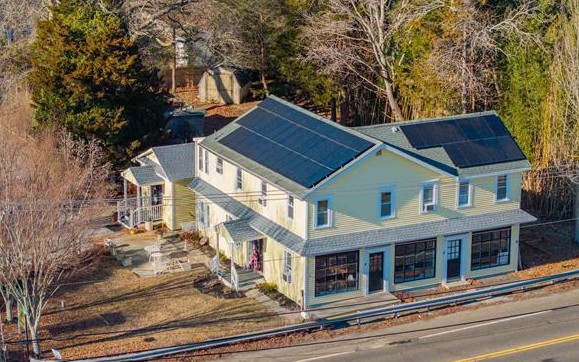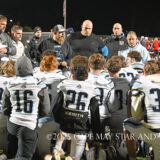Climate change research span boosts curriculum at LCMRH
ERMA — Education doesn’t stop at the classroom door at Lower Cape May Regional High School — it extends across the wetlands.
Using grant funding dedicated to climate resilience and environmental education, the district has built the Lower Cape May Regional Research Bridge, a project that doubles as a pedestrian bridge and a climate change research station.
The innovative structure is more than just steel and wood; it is a living classroom where students collect data, study ecosystems and see firsthand how climate change affects them.
According to the district, the bridge stands as a bold statement: our students don’t passively learn about the future — they are helping to shape it.
Vision realized through grants
When district leaders applied for the competitive Climate Change Resilience and Education grant, they had a vision: build an outdoor learning space that would last for decades.
The proposal combined infrastructure with education — the result was a bridge that would serve as both a research hub and a community landmark.
The district said Gov. Phil Murphy’s wife Tammy visited the school district, praising the project for its dual impact.
It not only provides real-world STEM opportunities for students but also contributes valuable climate data to the region.
By investing in this project, the district created a permanent, hands-on research site that enriches curriculum while addressing an important issue.
“This bridge gives our students a chance to be part of real science, right in their own backyard,” said Dr. Christine Teeney, director of Curriculum and Instruction at Lower Cape May Regional.
Living laboratory on the wetlands
At first glance, the bridge looks like a sturdy walkway connecting two sides of a tidal marsh. But built into its design are sensors, gauges and viewing areas that make it a cutting-edge research station.
Students can monitor water levels and salinity to track sea level rise, collect plant and soil samples and observe bird and fish populations to study habitat changes.
Teachers plan to use the bridge to compare tidal data before and after major storms and see how it correlates with weather patterns using the adjacent weather station.
Science teachers Evan Rundgren, Travis Davis and Jeff Martin, who helped to design the project, have created a variety of hands-on cross-curricular lesson plans for colleagues to use while taking classes out onto the bridge. Every trip onto the bridge turns into a field experiment, bringing textbook concepts to life.
“It’s one thing to read about climate change,” said Martin, who teaches oceanography, “but standing on the bridge during high tide and seeing the marsh flood — it makes it real.”
Transforming learning
The greatest beneficiaries of the project are the students themselves. The bridge has opened doors to a new style of learning: Inquiry-Based Science. Students can design their own experiments, ask big questions and test real hypotheses.
Students use math concepts to analyze data trends, English skills to write essays about the wetlands and art students sketch the landscape. This exposure to environmental technology prepares students for jobs in science, engineering and sustainability.
“Our students aren’t just learning about climate change, they’re becoming the next generation of problem-solvers,” Teeney said.
Linking schools with community
The bridge doesn’t serve only LCMR — it is a hub for the entire community. Local elementary and middle school students will visit for field trips, giving younger learners an early introduction to environmental science. Residents will be invited to join citizen science programs, helping to log tidal data or track bird migrations.
Partnerships with Stockton University, the state Department of Education and the Wetlands Institute ensure that research contributes to wider scientific efforts, strengthening the link between classroom learning and real-world impact.
Inspiring resilience in vulnerable region
Cape May County’s coastline is one of the areas most vulnerable to sea level rise and storm surges in New Jersey. For students who live here, climate change isn’t abstract — it’s personal.
The bridge stands as a symbol of resilience. It shows students that while challenges are real, solutions are possible. By learning how to measure, predict and adapt, they are better prepared to protect their community.
Looking ahead
The bridge already has sparked exciting new ideas. Future plans include drone mapping of the wetlands for aerial analysis. LCMR is home to a drones/aviation program in which students can earn dual credit with Atlantic Cape Community College.
Those participating in the course are required to pass a Federal Aviation Administration knowledge exam, which leads to earning the Federal Aviation Administration’s Remote Pilot Certificate with a Small Unmanned Aircraft Systems rating.
The RPC allows for the safe commercial operation of drones weighing less than 55 pounds in the National Airspace System.
Students in these courses can prepare simulations and share their research with peers across the state. The research could lead to expanded community workshops on coastal resilience and sustainability.
The long-term vision is for the bridge to become a regional model — an example for other school districts of how education and climate research can work hand in hand.
Bridge to the future
The bridge represents much more than a walkway across wetlands. It is a bridge between students and scientists, between learning and action and between today’s challenges and tomorrow’s solutions.
Through grant funding, visionary leadership and community support, the district has given its students a gift: the chance to learn by doing, to contribute to real research and to see themselves as capable leaders in the fight against climate change.
And as each new class crosses the bridge, they carry with them not just data notebooks and water samples — but the confidence that they can help shape a more resilient future.
“This bridge will outlast us,” Teeney said. “But more importantly, the lessons learned here will outlast even the bridge.”



